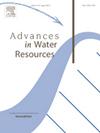A novel geometry-informed drag term formulation for pseudo-3D Stokes simulations with varying apertures
IF 4
2区 环境科学与生态学
Q1 WATER RESOURCES
引用次数: 0
Abstract
Alterations in the pore morphology of porous materials cause changes to the characteristic hydraulic properties, which are mostly non-linear and inherently difficult to predetermine. Assuming the alterations are known with sufficient accuracy, the relation between the altered pore structure, measured in terms of porosity, and intrinsic permeability may be determined by simulations with enormous computational effort. We focus on microfluidic experiments during the course of which the pore space becomes increasingly occupied with solid precipitate over elapsed process time. To analyze these domains, we present a novel geometry-informed drag formulation which allows for solving pseudo-3D Stokes equations for image-based input data of clogging porous media with accuracy and efficiency. In a pre-processing step, local pore space properties are analyzed and employed to spatially vary the magnitude of the drag term, which reflects the influence of neglected 3D effects. Calibration and validation is achieved through fully 3D Finite Difference Stokes simulations of different benchmark cases. With the proposed formulation we achieve the high accuracy of the pseudo-3D methods as far as permeability is concerned (30% deviation), but also with respect to local velocities, for a microfluidic domain throughout the clogging process. Noteworthy, the computational cost is being reduced to less than 1%. Combining the efficiency of a Stokes 2D simulation and accuracy of a 3D model the presented approach is rendered an interesting option to investigate remaining open questions, for example on anisotropy of effective hydraulic parameters during the clogging process.

具有不同孔径的伪三维Stokes模拟的一种新的几何通知阻力项公式
多孔材料孔隙形态的改变会导致其特征水力性能的变化,而这些变化大多是非线性的,并且本身就难以预先确定。假设变化具有足够的准确性,那么改变的孔隙结构(以孔隙度衡量)与固有渗透率之间的关系可以通过大量计算工作的模拟来确定。我们专注于微流体实验过程中,随着时间的推移,孔隙空间越来越多地被固体沉淀所占据。为了分析这些领域,我们提出了一种新的几何信息的阻力公式,该公式允许准确高效地求解基于图像的堵塞多孔介质输入数据的伪3d Stokes方程。在预处理步骤中,分析局部孔隙空间性质,并利用其在空间上改变阻力项的大小,这反映了被忽略的三维效应的影响。校准和验证是通过不同基准情况下的全三维有限差分斯托克斯模拟实现的。利用所提出的公式,我们在整个堵塞过程中实现了伪三维方法在渗透率方面(<;30%偏差)以及局部速度方面的高精度。值得注意的是,计算成本正在降低到不到1%。结合Stokes 2D模拟的效率和3D模型的准确性,该方法是一种有趣的选择,可以研究仍然存在的问题,例如堵塞过程中有效水力参数的各向异性。
本文章由计算机程序翻译,如有差异,请以英文原文为准。
求助全文
约1分钟内获得全文
求助全文
来源期刊

Advances in Water Resources
环境科学-水资源
CiteScore
9.40
自引率
6.40%
发文量
171
审稿时长
36 days
期刊介绍:
Advances in Water Resources provides a forum for the presentation of fundamental scientific advances in the understanding of water resources systems. The scope of Advances in Water Resources includes any combination of theoretical, computational, and experimental approaches used to advance fundamental understanding of surface or subsurface water resources systems or the interaction of these systems with the atmosphere, geosphere, biosphere, and human societies. Manuscripts involving case studies that do not attempt to reach broader conclusions, research on engineering design, applied hydraulics, or water quality and treatment, as well as applications of existing knowledge that do not advance fundamental understanding of hydrological processes, are not appropriate for Advances in Water Resources.
Examples of appropriate topical areas that will be considered include the following:
• Surface and subsurface hydrology
• Hydrometeorology
• Environmental fluid dynamics
• Ecohydrology and ecohydrodynamics
• Multiphase transport phenomena in porous media
• Fluid flow and species transport and reaction processes
 求助内容:
求助内容: 应助结果提醒方式:
应助结果提醒方式:


